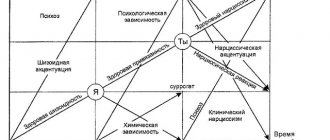Gestalt therapy: what is it in simple words
Any therapy is a treatment of what hurts: in the body or in the soul. Gestalt is integrity, completeness.
Gestalt therapy
- This is the treatment of unfinished actions that a person has.
An action is considered incomplete when we have some unpleasant situation, an unfulfilled need that interferes with a normal life. In simple terms, it is a splinter stuck in the heart that we cannot pull out.
Upbringing and character often do not allow one to express out loud one’s grievances, experiences, and negative emotions. We hold back in response to the insults of the offender.
At the time of a quarrel or an important conversation, we may not be able to express everything that we wanted to convey to a loved one.
But these negative emotions do not always disappear without a trace, they accumulate. All this unsaid, unlived in a timely manner periodically emerges and poisons existence, absorbing energy. Attacks of causeless sadness, melancholy, and discomfort are possible. Some unpleasant event from the past flashed through my head and my mood suddenly deteriorated.
Gestalt psychology recognizes that the main cause of all problems is the individual’s lack of ability to live in the present and the dragging of all failures from the past into the present moment.
Gestalt therapy is an approach that has two main goals
:
- Close the gestalt itself, free a person from it.
- Teach the individual to exist in the moment, in the “here and now” mode.
Why is it so important to get rid of the burden of the past? Accumulated unclosed gestalts are a time bomb and you never know in which direction it will explode!
For example, a woman who divorced her husband many years ago is grinding the details of their separation in her head, thinking about what she did or said wrong, analyzing how she could have behaved differently, and what would come of it.
It takes so much time and effort that there is no time left for real things in real life. In addition, she is still connected with her ex-husband, who has forgotten about her, and there is practically no chance of finding a new relationship.
Or a man is constantly humiliated by his manager, and he, afraid of losing income, remains silent and swallows the humiliation. But resentment and anger are accumulating inside him and the moment will come when they will spill out anyway, perhaps on his wife and children. And perhaps they will lead to serious illness.
At the first stage of treatment, the Gestalt therapist asks the client to play out a dialogue with a significant person and return to an unfinished situation. During such a dialogue, a person’s emotional reactions are monitored (this is called “phenomena”).
Returning to the affairs of bygone days can cause tears, vegetative-vascular reactions (the face becomes red), and trembling hands. This moment is an awareness of the problem.
The ultimate goal of treatment is to create a complete personality for the patient. A person needs to realize his problem, live it in the present time “here and now” and formulate a gestalt.
Basic methods and techniques
Gestalt therapy sessions can be either individual or group. Individual ones are more often used for people with post-traumatic disorder (people who have been to “hot spots”, survived a disaster, accident, etc.).
During a personal session, the client talks about what worries him and brings discomfort into his life. The psychologist teaches the client to think constructively and find a way out of the problem.
The prayer of the founder of the movement, F. Perzl, is widely known. Here is her text:
I am me. And you are you.
I am not in this world to live up to your expectations.
And you are not there to live in accordance with mine.
I am who I am. And you are you,
Amen.
Let's consider the main methods and techniques of treatment
.
"Here and now"
The main phrase in Gestalt therapy is “here and now”; a person is taught to experience all emotions in the present time and given conditions. The psychologist will listen to a story about the past, dreams and desires aimed at the future, but all emotions are analyzed in the present moment and place.
Speech changes
During therapy, the person is taught to rephrase statements in such a way that
:
- the question sounded like a statement;
- the statement was made on behalf of the man himself.
For example, the question: “Why don’t you love me?” should be replaced with the statement “I think you don’t love me.” This way you can convey the meaning of your experience more clearly and specifically, and focus on the essence of the problem.
The question “why” is generally not held in high esteem by psychologists, since it carries an aggressive accent and forces the one who is asked a priori to consider himself guilty and make excuses.
"Top and Bottom Dogs"
This method is used when a person has an internal conflict of two opposites, splitting consciousness. These two parts need to be put together to create a complete image.
The psychologist suggests conducting a dialogue first from one “dog” - aggressive, accusing, and then from the second - making excuses and apologizing, i.e. to be in the “skin” of each side of the conflict.
Dreams
The study of dreams is a key point in psychoanalysis. And although Gestalt therapy does not focus on working with the subconscious, dream analysis helps to work with the client’s problem, since from particles of dreams one can create a holistic image of a person.
Role-playing games
A common method is role-playing games, which are successfully used in collective Gestalt therapy sessions. A person is invited to play out certain situations and act in a certain role. The game process allows you to highlight certain personality traits and problems.
PREFACE
Specialists in the field of psychotherapy, and especially in the field of Gestalt therapy, will have a pleasant encounter with the published monograph by Serge Ginger and Anne Ginger, “Gestalt Therapy of Contact.”
In our country, since the 80s of the 20th century, interest in Gestalt therapy has been steadily increasing. The first to conduct Gestalt therapy in the USSR and then in Russia, both in the classical paradigm of F. Perls and combining it with group psychotherapy, were S. Yu. Kupriyanov, G. K). Kupriyanova, A.P. Fedorov, A.A. Alexandrov and the author of these lines.
Gestalt therapy, like its predecessor - analytical psychodrama, refers to methods of psychotherapy based on action. It is this feature that has made Gestalt therapy and analytical psychodrama the most popular in working with children and adolescents.
The monograph by S. Ginger and A. Ginger is characterized by high conceptualization, panoramic coverage of the theory, methodology and practice of Gestalt therapy, its connections with philosophy, spiritual practices of the East, other methods of psychotherapy and theories of personality.
Perhaps my statement will cause objections, but I have the impression that many Gestaltists of the second and third waves, including S. Ginger and A. Ginger, are engaged in structuring existing experience and contribute significantly to the fact that the anarchist mosaic of thoughts, fantasies, mythologies and therapeutic actions of F. Perls, P. Goodman and others are transformed into a strictly formalized scientific approach.
The monograph examines in detail the theories of self, the Gestalt cycle (contact cycle), the mechanisms of psychological defense - confluence, introjection, projection, retroflection, deflection and egotism.
The harmony in the description of the Gestalt therapy process is determined by the introduction by S. Ginger of an important definition - the “Ginger pentagram”, which includes five elements: the physical dimension, the effective dimension, the rational dimension, the social dimension, the spiritual dimension.
The monograph discusses the problems of transference and countertransference from the point of view of the Gestalt paradigm. Unfortunately, this topic is almost not covered in the domestic literature.
Reading the book by S. Ginger and A. Ginger evokes many thoughts and desires - agreeing with some statements and objecting to others. Of course, this monograph will not “close Gestalt” in a long debate about the advantages of some methods of psychotherapy and the disadvantages of others, the high or low effectiveness of different methods of psychotherapy, the economic feasibility and compliance of psychotherapy methods with the national and spiritual traditions of people living on earth.
The most important advantage of the monograph by S. Ginger and A. Ginger is that it is a knot on Ariadne’s thread, leading psychotherapists from different countries in their development from psychoanalysis to other humanistically oriented methods of psychotherapy, and through the development of these methods to the creation of a non-violent worldview.
E. G. EIDEMILLER, professor, doctor of medical sciences
Gestalt therapy exercises: examples
Within the framework of the described methods of Gestalt therapy, the following exercises are used.
Empty chair
A chair is placed in front of the person, with no one on it. The psychologist invites the client to address the chair as if a person were sitting on it and talk about all the problems. This helps, firstly, to let off steam, since there is no one on the chair and no one can be offended, and secondly, to look deeply into the essence of the experience.
missing man
This exercise is performed alone. You need to prepare a piece of paper and a pen and write down on it the person who was missing in your past (parents, grandmother, sister, friend, etc.). This is the person who, in our opinion, could make our life better.
Next, you need to describe what this person would be like, so that you can do things together, how to interact, what would make it easier for you both in the past and now.
Then try to understand whether compensation for this person has occurred in your current life, is there a replacement for him in the present?
The exercise will allow you to understand why certain people are near you and what childhood needs you have are not met.
Beating the sofa
If there has been unresolved resentment and anger at someone or something sitting inside for a long time, psychologists recommend taking a stick (another heavy object) and hitting a sofa, pillow or punching bag. Firstly, this will release old anger, and secondly, we will be able to clearly understand what is stopping us from living.
Society of Practicing Psychologists "Gestalt Approach" (SPP GP) program MOSCOW GESTALT INSTITUTE
Introduction.
During my training in Gestalt therapy and working as a Gestalt therapist, I came across a certain myth that exists in the background that a Gestalt therapist does not need to be interested in transference and countertransference, since due to our high level of awareness and ability to contact we can get rid of these aberrations. In addition, very little has been written on this issue in the literature on Gestalt therapy. I also suspect that practicing therapists, especially those who have recently been trained in Gestalt and, like me, have received little analytical training, think very little about transference and countertransference. So I hope this article will stimulate your interest in the possible presence of both transference and countertransference in your work with clients. For this article I have adopted the following framework:
- Definition - What psychotherapists usually understand by transference and countertransference.
- A little history - focus on the development and application of these concepts in psychoanalysis.
- A psychoanalytic perspective—the contemporary use of transference by psychoanalysts in clinical practice.
- Gestalt therapy perspective - what we think about and how we deal with manifestations of transference and counter-transference.• Clinical examples - some specific examples from my own clinical practice of how transference and counter-transference can manifest in a therapeutic context.
- Theoretical Issues - A closer look at some theoretical issues arising from the Gestalt approach that I find significant.
- Final comments.
DEFINITION
In attempting to define transference and counter-transference, I would like to emphasize that these notes represent theoretical constructs and not phenomenology (i.e., direct data in conscious experience), which is often assumed. They are simply pure ideas that we develop to explain certain observed phenomena. Please keep this in mind during this discussion. I will also ask you to remember that these definitions are inherently complex definitions, and I hope that you will sense the flavor of these discussions at the level of general understanding, and that therapists may have clearer or more specific definitions of what they understand on transference and countertransference In simple terms, transference is considered in connection with the “unconscious” (unconscious) process, which is said to be what the psychotherapy client projects onto the therapist as positive (desirable) and negative (undesirable) qualities that may actually belong to significant others in the client's past life (or the client may be projecting significant qualities or aspects of a past relationship), and then they behave or respond to influences as if he or she were that person (or is or could provide a relationship of the same quality). As a result, the client's actual feelings, thoughts, and behaviors addressed to the therapist are to some extent "unconsciously" influenced, colored, or distorted by early childhood experiences, especially those related to parents. From a Gestalt therapy perspective, this can be seen as a particular way in which the client may be organizing his experience of the therapist, which may be an interruption of contact. No doubt you have experienced something similar to the one described above (or more accurately, have somehow explained the experience in such terms ) both as a therapist and as a client. In my own client experience, I initially idealized my therapist, a view that I had eroded over many years of my own therapy. Now as a therapist, I think I continue to see major disturbances in the way I perceive my clients, especially in the early stages of our contact. What I observe, and I think it has clinical significance, is that such transference sometimes seems to operate almost indiscriminately (i.e., projection seems to occur widely and pervasively regardless of personality and context) and sometimes seems to that they are activated by certain stimuli (i.e. your gender, height, eye color, intonation, etc.), Countertransference can be seen as a process opposite to transference, in which the therapist projects onto the client. This additional concept to transference refers to the supposed process in which the therapist's feelings, thoughts and behavior towards the client may, to some extent, also be influenced by the so-called "unconscious" (unconscious) desires, feelings, reactions, fantasies etc., which stem from the therapist's early childhood experiences, but which now intrude and disrupt (without the therapist's awareness) the quality of the therapeutic relationship. This definition may seem too narrow to some. Some theoretical therapists (including Gestalt therapists) are willing to expand both concepts to include the completely unconscious reactions of therapist and client to each other. Such an expansion gives a very wide scope for discussion and the usefulness of special ideas about transference and countertransference. But in any case, I believe that the issue of unconscious reactions, especially on the part of the therapist, is extremely important, no matter what it is called. I believe that experience-based learning, as is the case in Gestalt therapy, provides an increase in the therapist's awareness and contact in order to reduce the impact of transference and counter-transference. I said "reduce" in the spirit of recognizing the limitations of our ability to know what we are doing at any given time. The therapist's relationship with his client is complex and may contain various problems and interacting interests. Recognizing this, and adding a little humor, I offer the following selection of possible transference and countertransference situations:
REASONS TO LOVE YOUR CLIENTS (ALL GOOD THERAPISTS DO THIS)
- My clients are people who truly take me seriously and value what I offer them.
- They constantly remind me that I'm not as crazy as I think I am.
- I love how they listen to my every word.
- I'm wondering how many more sessions I need to do to buy myself a new car.
- Amazingly, they come week after week.
- I can say what I want, and they will not object or contradict me, etc.
REASONS TO HATE THEIR CLIENTS (GOOD THERAPISTS SHOULD NEVER DO THIS)
- I need them and my well-being depends on them. They expect me to listen to them and always be attentive to them.
- They are terribly self-centered, there is very little room for me in this relationship.
- They are so slow to learn what is so obvious to me.
- They are so difficult to satisfy, it seems that they need more and more.
- They swear at you at all people.
- When they get what they want, they just leave you, etc.
A LITTLE HISTORY
The concepts of transference and counter-transference come from psychoanalytic theory. They have been considered by psychoanalysts since Freud and continue to be considered today as consequences and necessary conditions for the therapeutic relationship. It is also the belief of psychoanalysts that transference especially must be worked through and used to promote successful therapy. Freud initially felt that transference interfered with the therapeutic process and should be eliminated. But over time, he changed his views and then argued that “transference contains in living form the greatest difficulties in relationships that enter into neurosis” (Holmes and Lindl, 1989). He developed the concepts of transference and counter-transference as based on unconscious desires, from the patient or therapist, the meaning of which can only be inferred through psychoanalytic theory or interpretations. In this context, I would like to quote Freud's early work (Watching Transference-Love, 1915) to give you a little sense of the spirit of his thinking at that time: “For the physician, this phenomenon (i.e. transference-love) indicates a suitable piece for illumination and useful warning against any countertransference tendencies that may arise in our consciousness. He must learn that the patient’s love is generated by the situation of analysis, and not by the charm of our own person, so he has no reason to be proud of such a “victory”, as it would look like outside psychoanalysis.”
Further, in the same article, he offers the following interpretation:
“If one looks at the situation more closely, one can see the influence of motives... the patient's attempt to maintain his resistance, to destroy the authority of the doctor, lowering him to the level of a lover, and to obtain all the promised benefits, the satisfaction of love.” Some key elements that already appear for me in Freud's article , are that the client will transfer to the therapist qualities that belong to someone else; by and large, the personal qualities of the therapist are not relevant; and that the therapist should not take the client's projections personally. Freud then clearly suggests to the therapist what he should do: interpret the meaning of these projections and thus arouse the client's hidden motives, needs and feelings so that they can be recognized and consciously dealt with. Some might say, like Isidore Frome, that Freud discovered transference and counter-transference and thus made psychotherapy possible. Others may disagree with this and argue that both transference and counter-transference are purely theoretical constructs that constitute and support the theory and practice of psychoanalysis, and even if the present constitutes only a small part of what happens between therapist and client But more more on that a little later. First of all, I would like to examine more fully the analytical view of transference and counter-transference, and then contrast it with the Gestalt approach.
PSYCHOANALYTICAL VIEW
In psychoanalysis, what the therapist does is determined by the theory adopted. This orientation is a fundamental feature of analytic practice. Psychoanalysts have a universal belief that maladaptive behavior is determined by “unconscious” and repressed needs, feelings, impulses, etc.
The presumed nature of this "unconscious" material depends on the particular theory. For example, Freud emphasized the reproduction and resolution in the transference of the so-called Oedipal conflict. Klein's followers focus on the reproduction and definitive overcoming of so-called archaic depressions, suspicion and anger, and ego psychologists emphasize the need for "narcissistically disturbed" personalities to reproduce and work through and restore personality disturbances caused by the destruction of so-called early life objects through the reactivation and analysis of the transference of internal object objects. relationships.
Whatever actual content becomes preferable to a given analytic theory, all psychoanalysts use transference as the basis for their work as follows:
HOW ANALYSTS USE TRANSFER IN THEIR WORK
- Firstly, it is believed that present neurotic/maladaptive behavior is determined mainly by past experience
- Transfer is considered as a source of primary information about that most important past experience that is currently repressed and stored in the “unconscious”
- Psychoanalysts try to increase transference by limiting the natural expression of feelings and dialogue with the client in order to offer a “blank screen” onto which the client can unconsciously “project” their unresolved conflicts, needs, feelings, impulses, expectations, etc.
- All analysts need to draw conclusions based on the manifestations of transference in the client's actual behavior and the analyst's favorite theory regarding the client's likely early childhood experiences.
- An interpretation is then made based on the findings as if they were facts, and therapeutic intervention is suggested.
These principles apply to all psychoanalytic approaches. They differ in the content of interpretations, which are determined by the theoretical views of the therapist. A fundamental aspect of the psychoanalyst's practice (one of the things that distinguishes psychoanalysis from Gestalt therapy) is that the therapy is "theoretically guided." What the theory you accept as a psychoanalyst prescribes is what you should do. First, the theory is created on the basis of clinical material, then it is accepted and extended to a wide range of clients. The theory was originally a “drive theory.” Recently the emphasis has shifted to the need to work with the “idealized,” “reflected,” and “doubled” transference (Kogut).
VIEW OF GESTALT THERAPY
Gestalt therapy developed partly as a reaction to the theoretically driven methods of psychoanalysis and especially to its rigid commitment to cultivating the transference through the “neutral” status of the therapist. The practice of Gestalt therapy is a reaction to the view of psychoanalysts that meaning prevails over behavior. So, instead of focusing on unconscious restrictions, repressions, conflicts that influence behavior (that is, what could possibly happen), Gestalt therapists direct their attention to that. what is known in direct experience and what can be known later through directed awareness (the way each of us typically organizes and responds to our world). So the method that Gestalt therapy developed is based on what can be known in direct experience, and not on what cannot be known in immediate experience (i.e. the so-called “Unconscious”), with the exception of interpretation and transference analysis, as happens in psychoanalysis.
So it is not surprising that interest in transference and counter-transference has declined significantly in the practice and theory of Gestalt therapy. It is packed, so to speak, into the background. And the figure becomes oriented towards the following values:
FOCUS OF GESTALT THERAPY
- experience occurring “here and now” (i.e., current phenomenology), rather than “underlying influence of the past.”
- focus on "what is learned in experience and "how" we do what we do, and "how" we can responsibly choose other more conscious behavior, rather than explore, theorize explanations of how the supposed unconscious process influences on our behavior.
- reciprocal, natural, contact-filled dialogue between client and therapist rather than neutral, unnatural, transference-determined contact.
It is clear that transference is not central to the practice of Gestalt therapy, as it is in psychoanalysis. Where this occurs, it is seen as interruptions in contact and dealt with individually, :i not theoretically. Gestalt therapy does not have a special theory about what kinds of transferences can manifest themselves in therapy and how they should be handled. Rather, Gestalt therapy focuses its interest on expanding awareness to increase the self-support necessary for a creative and adaptive response to environmental influences. In short, by avoiding interpretation of behavior and by strengthening and expanding what appears to be suitable for awareness, what can improve - the ability to contact and to choose, Gestalt therapy collapses the significance of transference and counter-transference, considering them as a small part of the field that needs to be discerned .
Although Gestalt therapists are not as supportive of the development of transference, they recognize its existence. Transference and counter-transference are present in the background, arising spontaneously in the therapeutic relationship. Although Gestalt therapists may not use the psychoanalytic terms of transference and counter-transference, they are of course constantly dealing with transference behavior, transference reactions, perceptual errors, etc. But they view such projections as potentially useful in clarifying the internal, personal, and fulfilling view of their clients' (and their own) inner worlds that they create and respond to. Through the accurate identification of such projections by the therapist (i.e., recognition of projective material that does not correspond to the existing context), the past incomplete experience can be completed (which still continues to be projected onto the present situation and thus breaks contact), it will be clarified, recognized and completed at this time. Remaining alert to the transference responses of both the client and the therapist allows them to be better differentiated and thus minimize interruptions in contact resulting from inaccurate perceptions and subsequent inappropriate responses.
CLINICAL CASES
As I began to prepare some examples of possible signs of transference and countertransference, I soon realized that it was much easier for me to do this in relation to the future than to the past. Of course, even we therapists remain somewhat blind to our own projections, while the projections of others are completely obvious. So I strongly propose the following indicators of transference and counter-transference in order to recognize these tendencies. Also, as you read this list, don't forget that I've been repeating so much about the nature of transference and counter-transference, i.e. they are simply ideas to explain some of the perceived phenomena that we observe in our context. The examples I give here are not definitions or explanations in any way. They are simply illustrations of typical behaviors that are worth noting and exploring when working with clients.
SEVERAL POSSIBLE INDICATORS OF POSITIVE TRANSFER.
- the client never complains about your lateness,
- lack of attention, etc.
- the client says that he has finally found a person who truly understands him
- the client shows that you are really worth it
- every penny paid
- The client constantly makes the following comments:
“I always feel so good with you” “I have learned so much from you” “I always feel so safe with you” “You save my life” “I feel so calm with you” “You are so sensitive and receptive”
SEVERAL POSSIBLE INDICATORS OF NEGATIVE TRANSFERENCE
- the client tries not to share his feelings with you
- the client often misunderstands you and does not hear what you say
- the client is often confused
- the client denies your importance or the significance of therapy
- the client misrepresents your ideas, feelings, and responses
- the client lets you down when paying, i.e. pays slowly, complains that he is wasting money on you
- the client is often bored and is not interested in you
- the client attributes the successes of therapy to others, not to your therapeutic contact
- the client behaves as if you are not there
Of course, such behavior may be an adequate response to the therapist’s behavior. The client's positive perception may closely match your qualities (which would be nice). They can also indicate a reaction to qualities that the client is unconsciously projecting onto you. Likewise, negative responses can very accurately mean that you are actually boring, ineffective, and not as meaningful or important to the client as you would like. The task of therapy, by and large, is to find out what is true in this case.
Now, given the intense and obvious reactions that we as therapists may encounter in some clients, especially borderline psychotic clients, I believe that counter-transference responses are more difficult to notice and address and therefore require special attention. Here are some indicators that might suggest that something is going on, perhaps without the therapist's awareness, in the relationship with the client:
SOME POSSIBLE INDICATORS OF POSITIVE COUNTER-TRANSFERENCE:
- The therapist is overly protective and reactive
- patient vulnerability
- The therapist avoids dealing with the client's objections
- the therapist feels very sorry for the client and is included in him
- The therapist has idealistic reactions, possibly romantic impressions of the contact, focus on the attractive aspects of the client
- The therapist is attracted to the positive aspects of contact with the client, in terms of feelings of competence and value
- the therapist identifies with the client, i.e. feels closer, understands the client better, devotes more time
- the therapist idealizes the client's capabilities, i.e. I am optimistic about him.
SOME POSSIBLE INDICATORS OF NEGATIVE COUNTER-TRANSFERENCE
- The therapist attacks the client, i.e. offers difficult, humiliating experiments
- The therapist is often impatient, uninterested, and disconnected from the client
- the therapist thinks about how tired he is, how hungry he is, how overtired he is
- the therapist does not listen to the client, is immersed in dreams * the therapist feels unnecessary, inadequate, and is unsafe with the client
- The therapist over-talks, tells, interprets
- The therapist is arrogant, i.e. refers to old memories to demonstrate oneself
- The therapist becomes irritated or frightened by the client for no apparent reason
- The therapist frustrates the client, i.e. makes the client wait, rejects him, pushes him away.
I hope these examples have given you a flavor of what I'm talking about, it's quite possible that these ideas are nothing new to you.
SOME IMPORTANT THEORETICAL ISSUES
I have already emphasized how important it is to remember that transference and countertransference are not phenomena that we can observe directly, but rather hypothetical concepts (i.e., abstract theoretical concepts) useful in explaining or describing some special observed phenomena. These particular phenomena usually relate to the way our clients or ourselves respond inappropriately, out of context, and aloofly to each other in the therapeutic context. Transference and counter-transference are said to be a special kind of projection generated by our previous experiences, especially unsatisfactory early experiences. In this context, Gestalt therapists differ from psychoanalysts in that they avoid interpretation, proposing a mutual and authentic dialogic relationship, and about these accepted values I would like to say a little more.
I'm convinced that's the idea. that Gestalt therapists never interpret is a myth. It is fair to say that, unlike psychoanalysts, Gestalt therapists do not base their therapy on transferences and their interpretation. Rather, they focus on the experienced phenomenology and the development of dialogue in the current moment. But contrary to what Gestalt therapists say and do, I am convinced that they too interpret (often unconsciously) the meaning of their clients' behavior and report of their experiences. I believe that all therapists make inferences about what they observe. But the difference is that Gestalt therapists prefer to use these findings (when they are aware of them) differently than analysts. Instead of constructing specific interpretations based on some internalized theory, Gestalt therapists use their findings as the basis for experimental exploration of the client's direct experience. Their intention is to expand the client's self-awareness and thus expand the possible range of creative, adaptive behavior carried out by choice. But it would be foolish to believe that the active presence of the therapist and a constant focus on phenomenology can provide a relationship “free of transference and countertransference.”
Likewise, although Gestalt therapists offer their findings in the form of tentative ideas and experiments, it is possible that much is simply introjected by the client as a ready-made fact rather than being tried out and chewed on thoroughly. I think this is because of the mutual and equal relationship that Gestalt therapists talk about. that they offer them to their clients. - this is also a myth. Gestalt therapists value and ideally offer their clients a horizontal and equal relationship (i.e., they do not assume that they know anything better than their client). This is the opposite of how psychoanalysts propose a vertical relationship (ie they know as experts what is happening and what needs to be done). Gestalt therapists insist that because they offer clients such an equal relationship, it becomes possible for both client and therapist to develop their capacity to be fully present with each other, i.e. clear vision. hearing, feeling, thinking and relating appropriately to each other. Then they argue that if you act in this way, you can cope with any transference. I personally think that this is a somewhat naive position.
In fact. the therapeutic relationship is never equal. Clients seek therapists because they need help, they see therapists (we don't usually see them). Our clients are usually much more confused, anxious, addicted, ashamed, guilty, etc. than we are, and our clients usually pay us money for our psychotherapeutic skills. It is not my intention in this way to criticize the desire of Gestalt therapy to offer clients an equal relationship, but simply to warn about these aspects of the normal therapeutic relationship that need to be known to exist to varying degrees, and where they appear, they can affect the nature of the therapeutic relationship. relationships in a hidden and unconscious way and especially enhance transference. Your orientation towards equal, authentic and dialogical relationships does not guarantee their occurrence. It is clear that there are structural aspects of the therapeutic relationship that support the transference and can blind the therapist to his own counter-transference and are therefore always worth paying attention to.
CONCLUSION
Gestalt therapists have moved from an analytical emphasis on transference and its subsequent analysis and interpretation to an experiential and direct orientation based ideally on authentic and equal dialogue. In doing so, they hope to help their clients increase their self-awareness and ability to make choices and make adaptive contact with the environment. However, by adapting and using this method, they may tend to overlook the presence of transference and counter-transference and how this colors and affects the quality of contact with clients.
Just as it can be dangerous to create artificial transference and base the therapeutic relationship solely on theoretical interpretations, so too can serious problems arise if the importance of the hidden influences of transference (and counter-transference) is overlooked. If the therapist misses or downplays the presence of transference processes (and remembers that such processes are outside awareness by definition), then what appears to be happening in therapy is not actually happening at all, either between the client and the therapist, or within. I believe that by trying to address the obvious and the perceived, the Gestalt therapist underestimates the danger of arriving at false conclusions and interpretations. But even such an orientation can be picked up by the client as a desirable and necessary condition for being in therapy, perhaps as a response stimulated and supported by an unconscious transference process. By this I want to say that although transference is not directly supported in the practice of Gestalt therapy, it certainly arises and so needs to be paid attention to and then it gives the potential for countertransference.
Gestalt therapy training
In our country, you can obtain the qualifications of a Gestalt therapist in 4 basic institutions with international standards, three of which are located in Moscow and one in St. Petersburg.
Training future specialists begins with their selection
:
- the motives for learning are clarified in order to avoid further disappointment in the profession;
- applicants with severe psychopathology are eliminated.
As a first basic education, preference is given to medical or pedagogical education.
Training is carried out from the lowest (1) to the highest (3) level
:
- At stage 1, people with at least secondary education can study; upon completion, a certificate is issued. The basics of therapy and an introduction to the profession are taught.
- Stage 2 is for those who have completed the first stage courses or have secondary specialized and higher education. In conclusion, a certificate or certificate of professional retraining is also awarded.
- At stage 3, a choice of specialization is offered (working in a group, with children, other narrow areas). An international standard certificate is issued.
If all three stages are completed, then a three-year training is carried out in the areas of “supervisor in the Gestalt approach”, “group facilitator”. In the 4th year, training lasts 3 years.
Benefits of the program:
1. Practical orientation
Over six months of training, you will gain specific skills and techniques that you can use in practical work with clients. These same skills will help you “work on yourself”, turning it into a fascinating exploration of your own uniqueness.
2. Development of professional competencies
You will enrich your practice with the ability to subtly and deeply explore the client’s request, be in contact and see the dynamics of his condition. We will learn to work with the client’s phenomenology, feelings and needs, identify defense mechanisms and, of course, “close the gestalt.”
Working in a group, you discover and develop your own therapeutic style!
3. Knowledge and understanding of the theoretical aspects of the Gestalt approach.
Gestalt therapy is based on a set of simple, at first glance, but essentially profound concepts. Their development in the program occurs through
· comprehension and discussion of theory
practical work and
· own customer experience
The Gestalt approach integrates well with other approaches to therapy and counseling and will certainly enrich your professional worldview.
4. By participating in a group you receive therapy.
“It doesn’t matter where you work, the main thing is to improve yourself!”
Training takes place in a small (up to 12 people), closed group. In this space we will be able to pay attention to both the personal processes of each of the participants and the dynamics of the group itself. Six months of living in a group can change your life philosophy and add flavor and color to your life!
Upon completion of the program:
— you will be able to use the acquired knowledge and skills in consulting practice
— participants with specialized (psychological, pedagogical, medical and social) higher education will receive a certificate of advanced training; Participants without specialized education will receive an ICSR certificate of completion of the 1st stage program.
- if there is a recommendation from the program leader, continue training in the 2nd stage group of Gestalt therapy training.
Patient reviews
The effectiveness of the method is evidenced by reviews of clients who have undergone Gestalt therapy. Here are some of them.
Anastasia, 28 years old
“I realized that during therapy it is important to work on your own. You can't expect a psychologist to solve all my problems. I couldn’t sit back in my chair and enjoy the peace; it was very scary and painful, not physically, of course. You have to scrape out from inside all the nasty things and tears that have accumulated there.
Gradually, answers appear that I couldn’t find before, something stops worrying me completely, and the torment will probably stop. It’s good that I learned to close gestalts myself, I understood what needed to be done.”
Igor, 37 years old
“Some kind of insight came, I realized that over the past years, I had simply been neglecting myself and my life, and was going down the drain. It turned out that you need to fight for yourself, who would have told you how earlier.
For so many years I lived with other people’s expectations in the hope of recognition and praise. Who himself, what I want, has long forgotten. My own emotions had long ago died down, and therefore there was no sensory experience.
It turned out that a man has the right to emotions, and in general only they can lead to understanding his needs and desires. Like this. This is fucked up, how I lived, about nothing.
It’s a lot of work, of course, the psychologist only guides, you have to think a lot, but when the realization comes, you understand what to do next. And living in the current moment is generally cool!”
Reviews from people of different ages and genders, but they have one thing in common: Gestalt therapy is the work of two people (client and doctor), and its result is the path to your true self.










